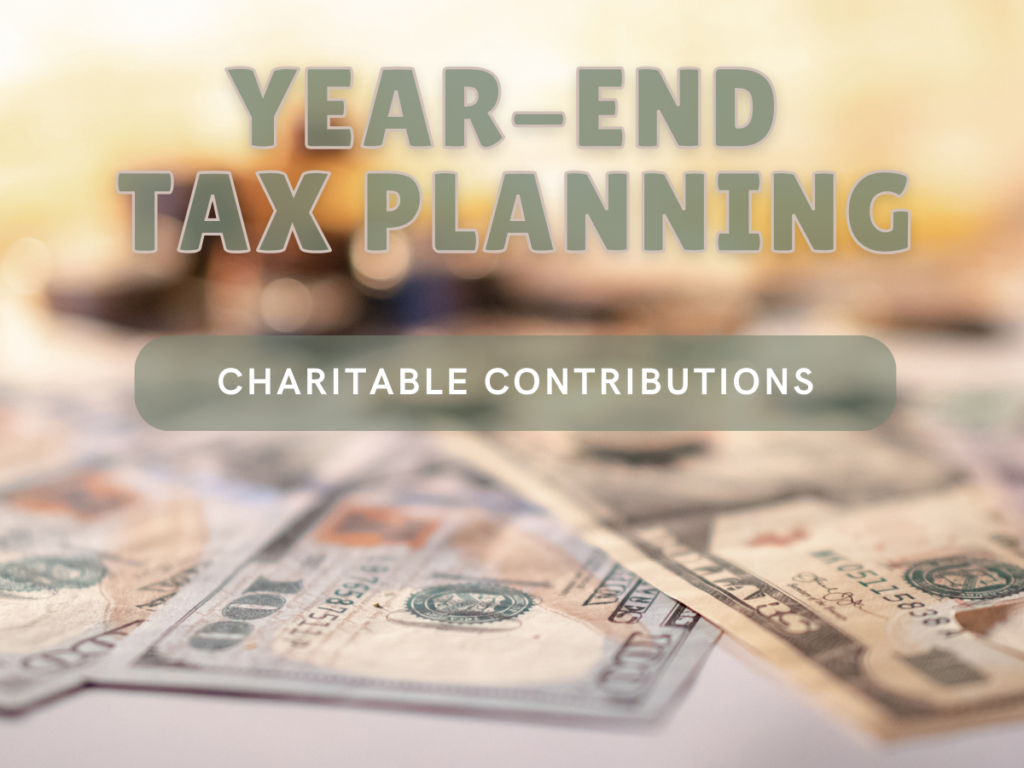As 2023 draws to a close, individual taxpayers can utilize a variety of tax planning strategies to help reduce taxable income. We will be posting a series of ideas to consider before year-end in order to minimize tax liability. See links under “Related Posts” for more tax-saving opportunities.
Charitable Contributions
With the holiday season right around the corner, many individuals embrace the spirit of giving. In fact, according to nationalgivingmonth.org, nearly one-third of annual charitable contributions occur in December, with approximately $166 billion donated to charitable organizations throughout the United States in the final month of 2022. This willingness to contribute to those less fortunate not only assists the charitable organizations, but can also provide benefits to the generous taxpayers by helping to reduce tax liabilities.
It is important to note that to take advantage of this strategy, a taxpayer must itemize deductions rather than taking the standard deduction provided by the government ($13,850 for single filers, $27,700 for married filing jointly, and $20,800 for head of household for 2023). For taxpayers with an itemized deduction amount that is near the standard deduction, donating to a charitable organization would be a great way to exceed that threshold and receive a larger tax deduction. There are several ways that taxpayers can donate to qualified charitable organizations (QCO) and increase their itemized deductions.
The most common donation method is cash. Individuals can contribute up to 60% of their adjusted gross income (AGI) to a charity and receive a deduction for the current year if they donate cash. If, instead of donating cash, the taxpayer decides to donate stock held more than one year directly to the QCO, the maximum deduction is 30% of AGI. In addition, the tax deduction for stock donations is calculated at the taxpayer’s fair market value of the stock, not the basis. Noncash items, such as used clothing or toys, can also be deducted on the taxpayer’s tax return as a charitable contribution. The value of these items is generally determined at the fair market value of what similar items are being sold for at places like thrift shops. The amount of noncash donations of this type is limited to 50% of the taxpayer’s AGI.
Finally, if the taxpayer is over the age of 73, a qualified charitable distribution (QCD) can be a tax-free way to redirect required minimum distributions (RMDs) to a qualifying charity (up to $100,000). This contribution not only reduces the taxpayer’s tax liability by eliminating income from the RMDs, but it can also result in a significant tax deduction. This strategy may be particularly beneficial to certain taxpayers who claim a standard deduction rather than itemizing because the donation is reported as a reduction to taxable retirement withdrawals, as opposed to as a separate deduction on Schedule A.
In addition to taking advantage of the federal tax benefits available for charitable contributions, Pennsylvania taxpayers can realize tax savings by participating in the Pennsylvania Education Improvement Tax Credit Program (EITC) or the Opportunity Scholarship Tax Credit Program (OSTC). These programs grant Pennsylvania tax credits of 75% or 90% of the donation amount, depending on the length of the commitment. Donors must reduce their federal tax deduction by the amount of the tax credit received. For taxpayers inclined to donate to an educational cause each year, this is a great way to shift Pennsylvania tax dollars to an organization close to their hearts. Click here for a quick video overview of the program provided by GYF’s Dan Oberst.
In conclusion, the end of the calendar year is a great time for individuals and families to donate to qualified charitable organizations. The donations help advance the missions of the organizations as well as providing tax-savings benefits to the donor. If you need assistance with your year-end or overall tax-planning strategy, please contact the GYF Tax Services Group at 412-338-9300.
Related Posts:
Year-End Tax Planning Strategies for Individuals – Residential Energy Credits
Year-End Tax Planning Strategies for Individuals – Tax-Loss Harvesting
Year-End Tax Planning Strategies for Individuals – Bunching of Itemized Deductions
Year-End Tax Planning Strategies for Individuals – Pre-tax and Self-employed Deductions
Year-End Tax Planning Strategies for Individuals – Securities






